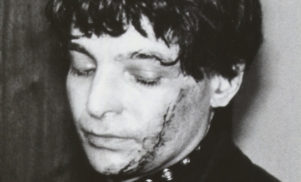Suicide frontman Alan Vega died in his sleep last July at age 78 and IT, his last solo effort (which is being touted as “his masterpiece and final statement”), has been released into the world. April Clare Welsh breaks down the master of destruction’s final grisly transmission.
Alan Vega didn’t dodge flying axes or slice his face with safety pins on stage as part of the US proto-punk innovators Suicide to just go gently into that good night. Vega, who died of natural causes last July at age 78, had one last grisly transmission to send out to the world, a blood-dripped album called IT that has just been released posthumously.
Between the years 2010 and 2016, Vega wrote and recorded IT, his eleventh solo album, with his wife and collaborator Liz Lamere. He intended IT to be both “his masterpiece and final statement” and his provocative personality bristles throughout. “Life is no joke,” Vega deadpans on the meta, industrial noise-laden first single ‘DTM’ (short for “dead to me”) before sinisterly crooning, “it’s days and nights of pure evil.”
Vega found inspiration for the record by “religiously consuming global news and taking frequent late-night walks alone throughout the streets of downtown New York.” As with longtime partner Martin Rev’s recent autobiographical album Demolition 9, the indomitable spirit of the city crashes around the album like an angry poltergeist.
The haunting ‘Motorcycle Explodes’ finds him wailing about “agony,” “misery,” and “river of blood”, before releasing the kind of death-rattle that Vega nailed during his days with Suicide. On ‘Prophecy’ Vega recalls the time he was mugged aged 71, blood dripping down his face: he’s “bruised everywhere, just like the good old days”, but will “get up”, “survive” and “go on and on and on” nonetheless. He hardly let the world – or his age – hobble him, even when it tried.
Alan Vega didn’t dodge flying axes or slice his face with safety pins on stage as part of US proto-punk innovators Suicide to just go gently into that good night.
Listeners will find his spirit more vibrantly on standout track ‘Prayer’. Here, the twisted evangelist preacher personality he had refined over the years truly comes to the fore. Over a crunchy drum loop and high-pitched organ drone, Vega yodels “hallelujah”, “meditation” and “war is over”, almost in a moment of catharsis. Death and suffering were intrinsic to Vega’s art. In his life, he was plagued by physical illness and as a visual artist, obsessed with crucification. Here it sounds like he may have finally found some peace.
The IT cover features a photograph Vega once took of an exit sign and the notion of departure, with Vega having suffered a heart attack and a stroke in 2012 while he was still writing the album, cannot be divorced from this record. The album hints that there is light at the end of the tunnel, tapping into the agony and the ecstasy of human life before its end.
Allen Ginsberg said Hugh Selby Jr.’s cult novel Last Exit To Brooklyn would “explode like a rusty hellish bombshell over America and still be eagerly read in a hundred years” and that quote rings true for Vega’s oeuvre. There are some artists that stand the test of time and there are others that completely transcend it – Vega proves to be the latter on IT and through his visual output.
Vega resumed exhibiting his work as a painter in the early 2000s after nearly two decades out of the spotlight and continued to paint right until his death, creating large-scale acrylic and graphite “Spirit” works, which will be exhibited to commemorate the first anniversary of his death this month – New York’s unofficial Alan Vega Week. Like this exhibition, the album enshrines Vega’s apocalyptic vision and iron-will in nine tracks of metallic, and at times violent, avant-noise, while suggesting that the passage of time has done little to dilute his searing anger. New York City’s enfant terrible raged against the dying of the light right up until his death – playing shows, making music, doing interviews – that is his legacy.
Read next: Suicide’s Alan Vega was the unwavering punk prophet of doom we deserved





































